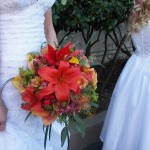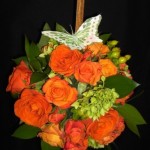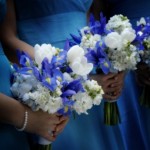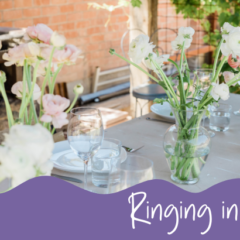The Guide to Wedding Flowers by Season
Planning your wedding day is like baking a great chocolate cake. You want to use a tried-and-true recipe, the best ingredients for the most flavor, and all the right tools for a glorious, rich dessert that looks and tastes like a million bucks-but without breaking the bank.
One of the most important decisions you will make about your wedding day is what flowers you will use for your wedding bouquet, bridesmaids bouquets, wedding centerpieces, boutonnieres, flower girl flowers and pew flowers. Nothing sets the mood for a wedding like flowers.
As the second most expensive item you'll choose (next to the wedding gown), it's important to choose wisely so that you get the most for your money and the atmosphere you desire. Just as in preparing a delicious meal, buying seasonal and local ingredients gives you the best results, both in expense and flavor. The same is true for flowers. Most flowers are distinctive to the seasons, so if you can take advantage of their ready availability, you will not only save money, but also have the best seasonal "ingredients" for your wedding day.Keep in mind that it's not necessary to use all the same flowers for all your wedding needs. Using a variety of flowers, colors and designs is the trend for today's weddings. According to leading floral expert, Rebecca Cole, "Wedding flowers follow fashion trends, and today, individuality, rather than convention is in style."
While most flowers bloom in a particular season, there are several that bloom year-round. Roses, anthuriums, orchids, tropical flowers, lilies and gerbera daisies are available anytime of the year. Roses are a traditional favorite for bridal bouquets, boutonnieres, centerpieces and corsages.
A great way to update roses is by using a vibrant color like orange, lavender or terra cotta. Hand-tied French twist bouquets incorporating ribbons and pearls give traditional roses a fresh look. Orchids and lilies make beautiful corsages for mothers and grandmothers, as well as for exotic wedding table centerpieces, and come in a variety of colors that would complement any color palette.Tropical flowers also make great centerpieces for the wedding and reception. For a casual, yet elegant look, gerbera daisies make beautiful bridesmaids bouquets and are available in an array of vibrant colors.
Spring Wedding Flowers
Spring boasts of new life and growth and if you are planning a spring wedding, you have a wide variety of flowers to choose from. Spring wedding flowers include apple and cherry blossoms, daffodils, dogwoods, forsythia branches, freesia, hyacinth, iris, larkspur, lilacs, Lily of the Valley, pansies, peonies, sweet peas and tulips.
Branch varieties like apple blossom, dogwood and forsythia make dramatic centerpieces, as well as altar decorations, pew flowers, and reception decor. Weathered urns get a face-lift with a combination of daffodils, hyacinth and tulips. A glorious bunch of over-sized pastel peonies with a simply tied satin ribbon makes a luscious bridal bouquet, as do a bunch of drooping tulips.
Summer Wedding FlowersIf you are planning a wedding during the summer months (with June being the most popular wedding month), you have many flower choices to incorporate into your wedding. Calla lilies, dahlias, daisies, delphinium, geraniums, gladiolas, hydrangeas, iris, Jacobs Ladder, larkspur, Queen Anne's Lace, Shasta daisies, stock, sunflower, tuber rose and zinnias are all in season June through August.
Among the most popular summer wedding flowers for bridal bouquets and bridesmaids bouquets are miniature calla lilies for their long lines and striking flower. Gladiolas also work well for the same reasons. But don't underestimate the simple beauty of daisies, which can work for corsages, boutonnieres, flower girl flowers, and food tables. Tropical flowers also work great for summer weddings as centerpieces and non-traditional bridal and bridesmaids bouquets.
Fall Wedding Flowers
A Fall wedding can celebrate the beauty of the harvest season with fall wedding flowers like amaranthus, asters, berries, chrysanthemums and marigolds. A combination of these make especially beautiful Fall wedding centerpieces, food table flowers and pew flowers. Chrysanthemums and marigolds look festive in rustic urns or ceramic pots. Berries can add that seasonal touch to wedding bouquets, as well as to the groom's and groomsmen's boutonnieres.
Winter Wedding Flowers
The starkness of winter can be a dramatic backdrop to a wedding. Winter wedding flowers include amaryllis, camellias, evergreen, forget-me-nots, gardenia, holly, jasmine, pinecone, poinsettias and Star of Bethlehem. Poinsettias are probably the most noted winter flower and make a bold statement with their velvety petals. But don't forget fragrant gardenias, jasmine and camellias for elegant winter bouquets. The abundance of evergreen, pinecone and holly make festive additions to bouquets, wedding centerpieces, food tables and altars.
So, whatever month you are planning a wedding, let the season be your guide for the freshest flowers at the best prices. You can't go wrong with the best blooms each season has to offer. And the impact they make on your wedding day will be even better than the icing on the cake!
To read more interesting newsletters like this one go to WPN newsletters. Have a topic you would like to see in a Wedding and Party Network newsletter or on the WPN Blog? Submit your ideas to WPN Ask or Share.








Leave a Reply